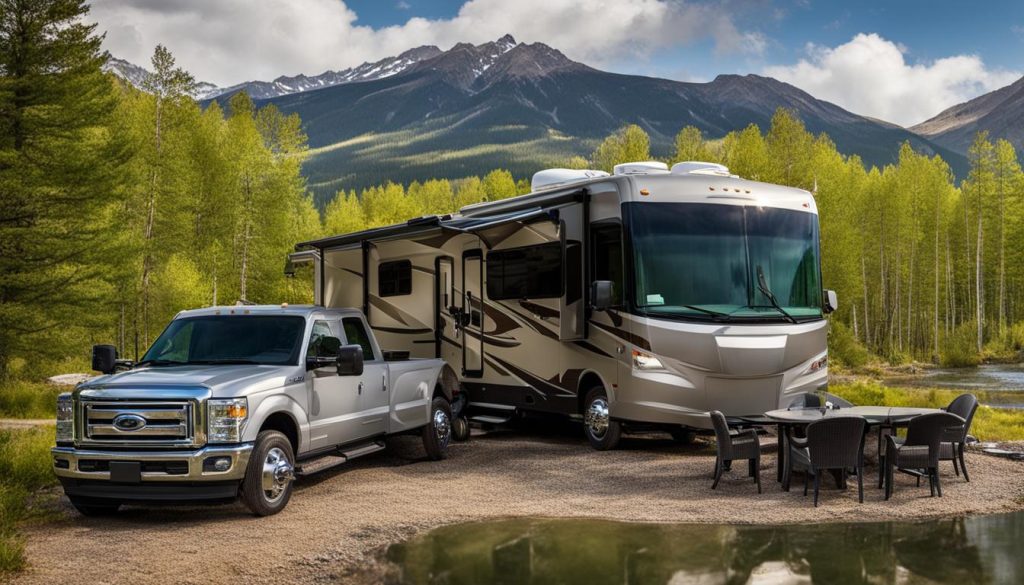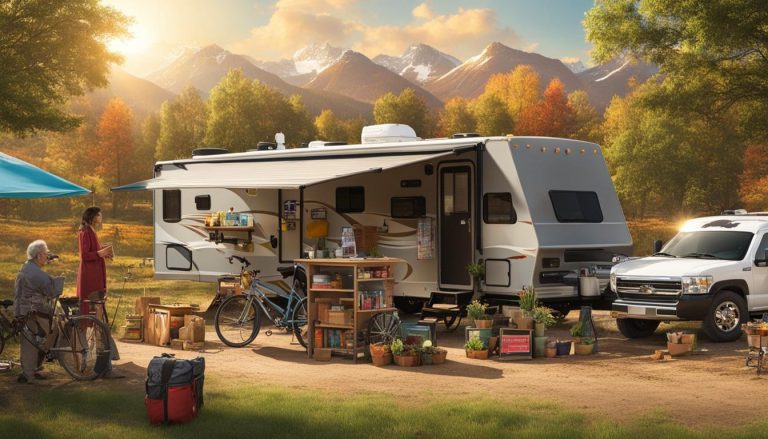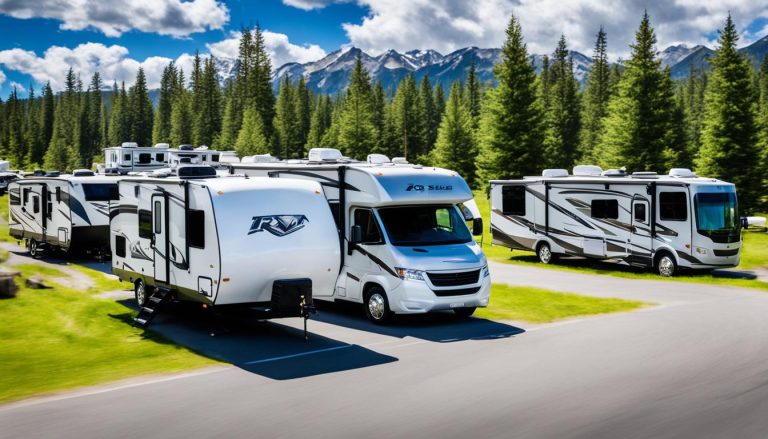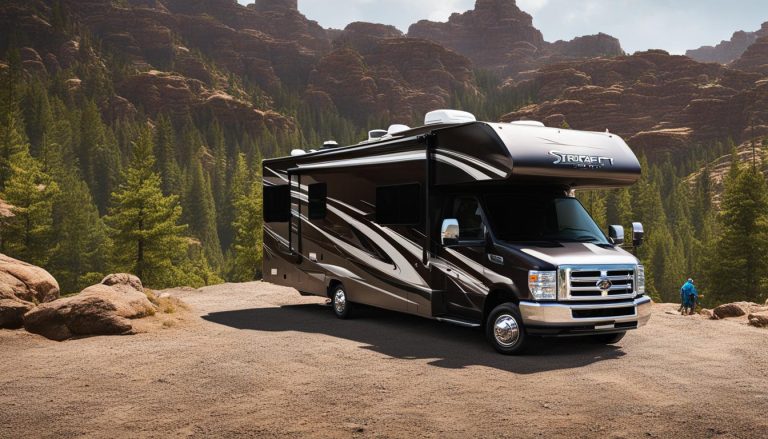RV Septic Connection Guide: Easy Steps
gorvlifestyle.com and its partners may earn a commission if you purchase a product through one of our links
Are you an RV owner wondering if you can connect your RV to a septic tank? The answer is yes! Connecting your RV to a septic tank can provide a convenient way to manage waste while camping. However, it’s essential to understand how septic tanks work to ensure a successful connection.
Septic tanks have two compartments that filter wastewater and separate solids from liquids. The natural bacteria in the tank break down the wastewater, which is then filtered through the soil. To connect your RV to the septic tank, the easiest way is through a cleanout, a PVC pipe with a screw cap. Simply remove the cap and attach your RV’s sewer hose to the cleanout, ensuring it is properly secured.
It’s important to avoid overloading the septic tank and to refrain from dumping excessive amounts of cleaning solutions or toilet wipes, as they can disrupt the balance of bacteria in the tank. Regular maintenance and precautions are necessary to ensure the proper functioning of your septic tank and RV waste disposal system.
Key Takeaways:
- Connecting your RV to a septic tank is possible and can provide convenient waste management while camping.
- Septic tanks have two compartments that filter wastewater and rely on natural bacteria to break down the waste.
- Connecting your RV to a septic tank is often done through a cleanout, a PVC pipe with a screw cap.
- Avoid overloading the septic tank and refrain from dumping excessive amounts of cleaning solutions or toilet wipes.
- Regular maintenance and precautions are necessary to ensure the proper functioning of your septic tank and RV waste disposal system.
How to Connect your RV to the Septic Tank
To connect your RV to the septic tank, you will typically find a clean out, which is a PVC pipe that comes out from the ground with a screw cap. Remove the cap and attach your RV’s sewer hose to the clean out, ensuring it is properly secured.
You can choose to leave this connection hooked up all the time so that any wastewater automatically goes into the septic system, or you can choose to wait and empty the tank all at once. However, it’s important to avoid overloading the septic tank at one time, as this can cause shock to the system.
It’s recommended to keep a balance between the bacteria and wastewater in the septic tank to ensure proper functioning. If your septic tank doesn’t have a clean out, it’s dangerous to remove the lid and dump directly into the tank. Exposure to too much air can kill the natural bacteria in the tank, and the gas trapped in the tank can be fatal to humans. If you do choose to dump directly into the tank, make sure to dump into the correct side that keeps the solids separate from the wastewater.
Remember, you cannot use an access port as a continuous way to drain RV wastewater. It is crucial to follow these steps for safe and effective connection of your RV to the septic tank. By understanding the proper connection process, you can ensure the smooth and efficient disposal of wastewater during your RV camping experience.
Benefits of using a cleanout for RV septic tank hookup:
| Benefits | Explanation |
|---|---|
| Ease of connection | Using a cleanout makes it simple to attach your RV’s sewer hose securely to the septic tank. |
| Automatic wastewater disposal | Leaving the connection hooked up allows for convenient and automatic disposal of wastewater into the septic system. |
| Safe and proper functioning | By maintaining a balance between bacteria and wastewater, you ensure the septic tank operates efficiently without shocks or disruptions. |
Tips for Keeping Your Septic Tank Working Well
After connecting your RV to the septic tank, it’s important to take additional precautions to ensure the proper functioning of the system. Follow these tips to keep your septic tank working well and maintain an efficient RV waste management system.
Avoid Excessive Use of Additional Chemicals
While it may be tempting to use various chemicals to keep your septic tank clean, it’s best to avoid excessive use. Dumping large amounts of additional chemicals down your drains can disrupt the balance of bacteria in the tank and potentially kill off the necessary natural bacteria. This can lead to a less efficient breakdown of waste and a compromised septic system.
Use Caution with Septic Tank Cleaners
Be cautious when using septic tank cleaners that are sold commercially. While they may temporarily provide a cleaner system, they can also disturb the delicate balance of bacteria in your septic tank. It’s important to maintain a healthy bacterial environment to ensure the proper breakdown of waste in your RV waste management system.
Avoid Overloading the System
Be mindful of the amount of wastewater you introduce into the septic tank at one time. Dumping excessive amounts of wastewater can overload the system and potentially cause sludge to enter the leach lines, leading to clogs and issues with proper draining. It’s best to spread out the use of your RV’s plumbing to prevent overloading the septic system.
Maintain Regular Cleaning and Maintenance
Regular maintenance is key to keeping your septic tank in good working condition. Consider having your septic system cleaned more frequently if you use your RV’s plumbing frequently. This will help prevent any potential problems that may arise from a buildup of waste in the tank. Regular cleaning and maintenance will ensure that your septic tank functions properly and prevents any issues with your RV waste management system.
Properly Dispose of Waste
Be mindful of what you flush down your RV’s plumbing system. Avoid dumping items that could potentially clog or disrupt the septic tank, such as coffee grounds, grease, or sanitary products. These items can cause blockages or inhibit the natural breakdown of waste in the septic tank. Dispose of waste properly to maintain a healthy and efficient septic system.
By following these tips, you can ensure that your septic tank works well and your RV waste management system functions properly.
Understanding How Septic Tanks Work
Before connecting your RV to a septic tank, it’s important to understand how septic tanks work. Septic tanks play a crucial role in wastewater management in both residential and recreational vehicle settings. Knowing the basics can help you make informed decisions and ensure the proper functioning of your RV’s septic system.
Septic tanks consist of two compartments that work together to filter wastewater and separate solids from liquid. The process starts with the initial settling compartment, where heavier solids sink to the bottom and form a layer of sludge. Lighter materials, like fats, oils, and greases, rise to the top, creating a layer of scum. The liquid waste in between, known as effluent, flows into the second compartment.
Once in the second compartment, the effluent undergoes further treatment. Natural bacteria, present in the tank, break down the organic materials in the wastewater, decomposing them into simpler compounds. This biological process helps remove harmful pathogens and pollutants from the effluent.
After the decomposition process, the effluent is ready for disposal. It flows out of the tank and into a drainfield or leach field, where it percolates through layers of soil. The soil acts as a natural filter, removing any remaining impurities and allowing the treated wastewater to safely reenter the environment.

It’s important to maintain a delicate balance within the septic tank to ensure optimal performance. This means avoiding the introduction of substances that can disrupt the natural bacterial activity. Dumping excessive amounts of cleaning solutions, toilet wipes, or coffee grounds can impair the effectiveness of the septic tank and lead to clogs or system failures over time.
By understanding how septic tanks work, you can better appreciate the importance of regular maintenance and proper waste disposal practices. With this knowledge, you’ll be equipped to make informed decisions that promote the longevity and efficiency of your RV’s septic system.
Maintaining Your RV’s Septic System
Proper maintenance of your RV’s septic system is essential for a worry-free camping experience. Emptying your septic tanks on a regular basis is an unglamorous but necessary part of RVing. The frequency of emptying the tanks depends on how much you use them. It’s recommended to wait until your tanks are about two-thirds full before emptying them to create a better flow when dumping. Some RV systems have sensors to show the tank levels, but these sensors may not always work accurately.
Flushing, cleaning, and sanitizing your tanks regularly will help keep the system running smoothly. It’s important to use single-ply toilet paper, regularly add water to the toilet bowl before flushing, and sanitize the tanks after dumping. Additionally, proper care of the fresh water tank, gray water tank, and black water tank is necessary to prevent any issues.
To maintain your RV’s septic system:
- Empty the septic tanks when they are about two-thirds full.
- Flush, clean, and sanitize the tanks regularly.
- Use single-ply toilet paper.
- Add water to the toilet bowl before flushing.
- Sanitize the tanks after dumping.
- Care for the fresh water tank, gray water tank, and black water tank.
By following these maintenance tips, you can ensure a properly functioning RV waste disposal system.

| Tank | Frequency of Maintenance |
|---|---|
| Septic Tank | Empty when about two-thirds full |
| Fresh Water Tank | Clean and sanitize regularly |
| Gray Water Tank | Empty when necessary |
| Black Water Tank | Empty when about two-thirds full, flush, clean, and sanitize regularly |
The Benefits of Using an RV Septic System
Using an RV septic system offers several benefits for RVers. Connecting your RV to a septic tank allows for a convenient and easy way to manage waste while camping. It provides additional living space and privacy when using an RV as a guest house or extra accommodation. By properly connecting your RV to a septic tank and following maintenance guidelines, you can enjoy a worry-free camping experience. It’s important to understand the process of connecting and maintaining the septic system to fully utilize its benefits. Whether you’re a new RV owner or planning to rent an RV, knowing how to connect and maintain the RV septic system is essential for a smooth camping experience.
| Benefits of RV Septic System | Description |
|---|---|
| Convenience | Easy waste management while camping |
| Additional Space | Use your RV as a guest house or accommodation |
| Privacy | Avoid using public facilities |
| Peace of Mind | Properly maintained septic system ensures worry-free camping |
By utilizing an RV septic system, you can enjoy the convenience of managing waste directly from your RV. No more relying on public restrooms or worrying about finding a suitable dumping location. With a properly connected RV septic system, you can maintain your privacy and enjoy the comforts of your own RV, even when hosting guests.
“Using an RV septic system allows for a convenient and easy way to manage waste while camping.”
– RV Enthusiast
Understanding how to connect and maintain the RV septic system is crucial for a seamless camping experience. By following the proper steps and guidelines, you can ensure that your waste disposal system functions optimally and avoid any potential issues.
Additional Tips for RV Sewer System Maintenance
In addition to the steps mentioned above, there are a few more tips for maintaining your RV’s sewer system. One important tip is to consider adding a p-trap to your sewer discharge hose to control odors when camping on hookups with your gray tank valve open. P-traps create a water barrier that helps prevent sewer gases from entering your RV, ensuring a pleasant camping experience.
Another crucial step is to check and comply with campground rules and regulations regarding sewer hose requirements. Some campgrounds may require the hose to be elevated above the ground to prevent any potential issues. By following these guidelines, you can avoid any violations and ensure a smooth and hassle-free camping experience.
Regularly cleaning and inspecting your sewer hose is also essential for its longevity and effectiveness. Over time, debris and residue can accumulate, leading to clogs and unpleasant odors. By cleaning your sewer hose regularly, you can prevent these problems and keep your RV waste disposal system in optimal condition. Remember to thoroughly inspect the hose for any signs of wear and tear and replace it if necessary to avoid leaks or other issues.
By following these additional tips, you can ensure the proper functioning of your RV sewer system and minimize odors and issues. Proper maintenance is key to enjoying your camping trips while keeping the environment clean and healthy.
FAQ
Can I connect my RV to a septic tank?
Yes, you can connect your RV to a septic tank. However, it’s important to understand how septic tanks work and follow the proper steps for connection.
How do I connect my RV to the septic tank?
The easiest way to connect your RV to a septic tank is through a clean out, which is a PVC pipe with a screw cap. Remove the cap, attach your RV’s sewer hose to the clean out, and secure it properly.
What precautions should I take when connecting my RV to the septic tank?
Avoid overloading the septic tank with excessive amounts of wastewater or cleaning solutions. It’s also important to properly maintain and balance the bacteria levels in the tank.
How often should I empty my RV’s septic tank?
The frequency of emptying the septic tank depends on your usage. It’s recommended to wait until the tanks are about two-thirds full before emptying them to create a better flow when dumping.
What should I avoid dumping into the septic tank?
Avoid dumping excessive amounts of cleaning solutions, toilet wipes, or coffee grounds into the septic tank, as they can disrupt the balance of bacteria and cause damage.
How do septic tanks work?
Septic tanks have two compartments that filter wastewater and separate solids from liquid. The natural bacteria in the tank break down the wastewater, which is then filtered through the soil.
How can I maintain my RV’s septic system?
Regularly emptying, flushing, cleaning, and sanitizing your RV’s septic tanks is important for proper maintenance. Use single-ply toilet paper and add water to the toilet bowl before flushing.
What are the benefits of using an RV septic system?
Connecting your RV to a septic tank allows for convenient waste management while camping and provides additional living space and privacy.
Any additional tips for RV sewer system maintenance?
Consider adding a p-trap to control odors, check campground rules for sewer hose requirements, and regularly clean and inspect your sewer hose for longevity and effectiveness.






